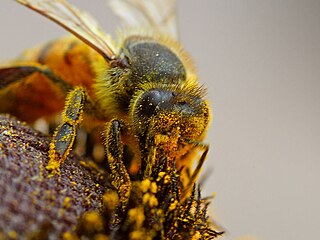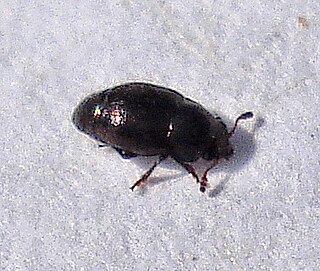
Pollen is a powdery substance consisting of pollen grains which are male microgametophytes of seed plants, which produce male gametes. Pollen grains have a hard coat made of sporopollenin that protects the gametophytes during the process of their movement from the stamens to the pistil of flowering plants, or from the male cone to the female cone of coniferous plants. If pollen lands on a compatible pistil or female cone, it germinates, producing a pollen tube that transfers the sperm to the ovule containing the female gametophyte. Individual pollen grains are small enough to require magnification to see detail. The study of pollen is called palynology and is highly useful in paleoecology, paleontology, archaeology, and forensics. Pollen in plants is used for transferring haploid male genetic material from the anther of a single flower to the stigma of another in cross-pollination. In a case of self-pollination, this process takes place from the anther of a flower to the stigma of the same flower.

Entomophily or insect pollination is a form of pollination whereby pollen of plants, especially but not only of flowering plants, is distributed by insects. Flowers pollinated by insects typically advertise themselves with bright colours, sometimes with conspicuous patterns leading to rewards of pollen and nectar; they may also have an attractive scent which in some cases mimics insect pheromones. Insect pollinators such as bees have adaptations for their role, such as lapping or sucking mouthparts to take in nectar, and in some species also pollen baskets on their hind legs. This required the coevolution of insects and flowering plants in the development of pollination behaviour by the insects and pollination mechanisms by the flowers, benefiting both groups.

The family Oedemeridae is a cosmopolitan group of beetles commonly known as false blister beetles, though some recent authors have coined the name pollen-feeding beetles. There are some 100 genera and 1,500 species in the family, mostly associated with rotting wood as larvae, though adults are quite common on flowers. The family was erected by Pierre André Latreille in 1810.

Diploptera, also known as the beetle cockroach, is a genus of blaberid cockroaches. Cockroaches of this genus resemble beetles, with hardened tegmina and cross-folded hindwings. They live in tropical forests in South China and Southeast Asia, and Pacific islands including Hawaii. They are viviparous cockroaches and are therefore used for insect endocrinological studies. There are eight known species and two subspecies.
Androlyperus is a genus of skeletonizing leaf beetles in the family Chrysomelidae. There are about five described species in Androlyperus. They are found in North America and Mexico.

Dythemis nigrescens, the black setwing, is a species of skimmer in the dragonfly family Libellulidae. It is found in Central America and North America.

Bruchus pisorum, known generally as pea weevil, is a species of leaf beetle in the family Chrysomelidae. Other common names include the pea beetle and pea seed beetle. It is found in Europe and Northern Asia, North America, and temperate Asia.
Acanthogethes fuscus is a species of pollen beetle in the family Nitidulidae. It is found in Africa, Europe and Northern Asia, and North America.
Acanthogethes is a genus of pollen beetles in the family Nitidulidae. There are about five described species in Acanthogethes.

Brachypterus is a genus of short-winged flower beetles in the family Kateretidae. There are about 18 described species in Brachypterus.
Phloeosinus sequoiae is a species of crenulate bark beetle in the family Curculionidae. It is found in North America.

Celastrina echo, known generally as the echo azure or western azure, is a species of blue in the butterfly family Lycaenidae.
Cerceris nigrescens is a species of wasp in the family Crabronidae. It is found in North America.

Apatides is a genus of horned powder-post beetles in the family Bostrichidae. There are at least four described species in Apatides.
Fabogethes is a genus of pollen beetles in the family Nitidulidae. There are at least two described species in Fabogethes.
Micromimus is a genus of true weevils in the beetle family Curculionidae. There are about 18 described species in Micromimus.
Sphaericus is a genus of spider beetles in the family Ptinidae. There are more than 30 described species in Sphaericus.
Afrogethes saevus is a species of pollen beetle in the family Nitidulidae. It is found in North America.
Brassicogethes cleominis is a species of pollen beetle in the family Nitidulidae. It is found in North America.
Tabanus nigrescens is a species of horse fly in the family Tabanidae.








